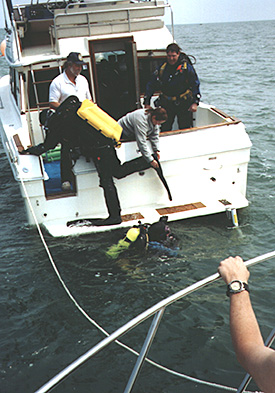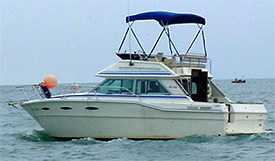Cleveland Underwater Explorers, Inc. (CLUE) is a non-profit corporation whose membership includes divers and historians who are dedicated to researching, locating, exploring, and documenting the shipwrecks and submerged history of the Great Lakes with an emphasis on Lake Erie. CLUE is based in Cleveland, Ohio, United States of America, on the southern shore of Lake Erie.

David VanZandt (left, hat) and Kevin Magee (standing, right) assist divers during the survey of the barge Craftsman (Photo by Maritime Archaeological Survey Team, MAST).
CLUE was founded by David VanZandt and Kevin Magee in 2001. Chief Researcher Jim Paskert joined the team in 2004 and Tom Kowalczk in 2007. These members form the core of the organization which also includes other associate members. The team consists of individuals skilled in many areas required for underwater exploration and survey including; archival research, Great Lakes history, Great Lakes ship construction styles and techniques, underwater search equipment operations and techniques, underwater archaeological survey techniques, mechanical and electrical engineering, and recreational and technical scuba diving.
The team predominantly uses David VanZandt’s boat the R/V Sea Dragon, a 30-foot (9 meter) Sea Ray based in Cleveland, Ohio. CLUE’s search equipment includes an Imagenex Model 872 Yellow Fin sidescan sonar and a J.W. Fishers Proton 3 magnetometer to locate and identify submerged objects. The boat is outfitted with GPS tracking/plotting equipment and bottom sounders. CLUE has the capability of using its search equipment in a stand-alone configuration to allow search and survey operations from other platforms.

The R/V Sea Dragon operating in Lake Erie (Photo by Gary Humel).
David VanZandt and Kevin Magee are both employed as contract aerospace engineers for the NASA Glenn Research Center and have more than thirty-five years experience between them designing, building, testing, and operating fluids and combustion experiments on the Space Shuttle, sounding rockets, and International Space Station. David has recently completed his Graduate Certificate in Maritime Archaeology from Flinders University, in Adelaide, South Australia, and is currently pursuing his Masters degree under the same program. Jim Paskert is the President and CEO of a supplier for industrial vacuum automation components, and Tom Kowalczk is an executive at an automotive supplier company.
Both Kevin and David are technical divers and have been trimix certified since the late 1990’s. Kevin started diving in 1984, and David started diving in 1995. David also does underwater photography and video. Jim began diving and researching Great Lakes shipwrecks in 1966 and discovered his first shipwreck, the steamer Sand Merchant, in 1969. His impressive resume includes a very long list of diving, shipwreck discoveries, and related accomplishments. Tom began diving and discovering Great Lakes shipwrecks in 1965 and has been involved in Great Lakes history ever since, including actively participating in the Canadian Pt. Pelee Passage shipwreck survey project.
CLUE continues to research and discover the underwater cultural heritage of Lake Erie and the other Great Lakes. Look for more about CLUE on this site in the coming weeks or visit their web site at: http://www.clueshipwrecks.org.
View other CLUE posts on the MUA:
The 2012 Season
The 2011 Season
The 2010 Season
The 2009 Season
The 2008 Season
The 2007 Season
Past Projects
Return to In The Field home page.




